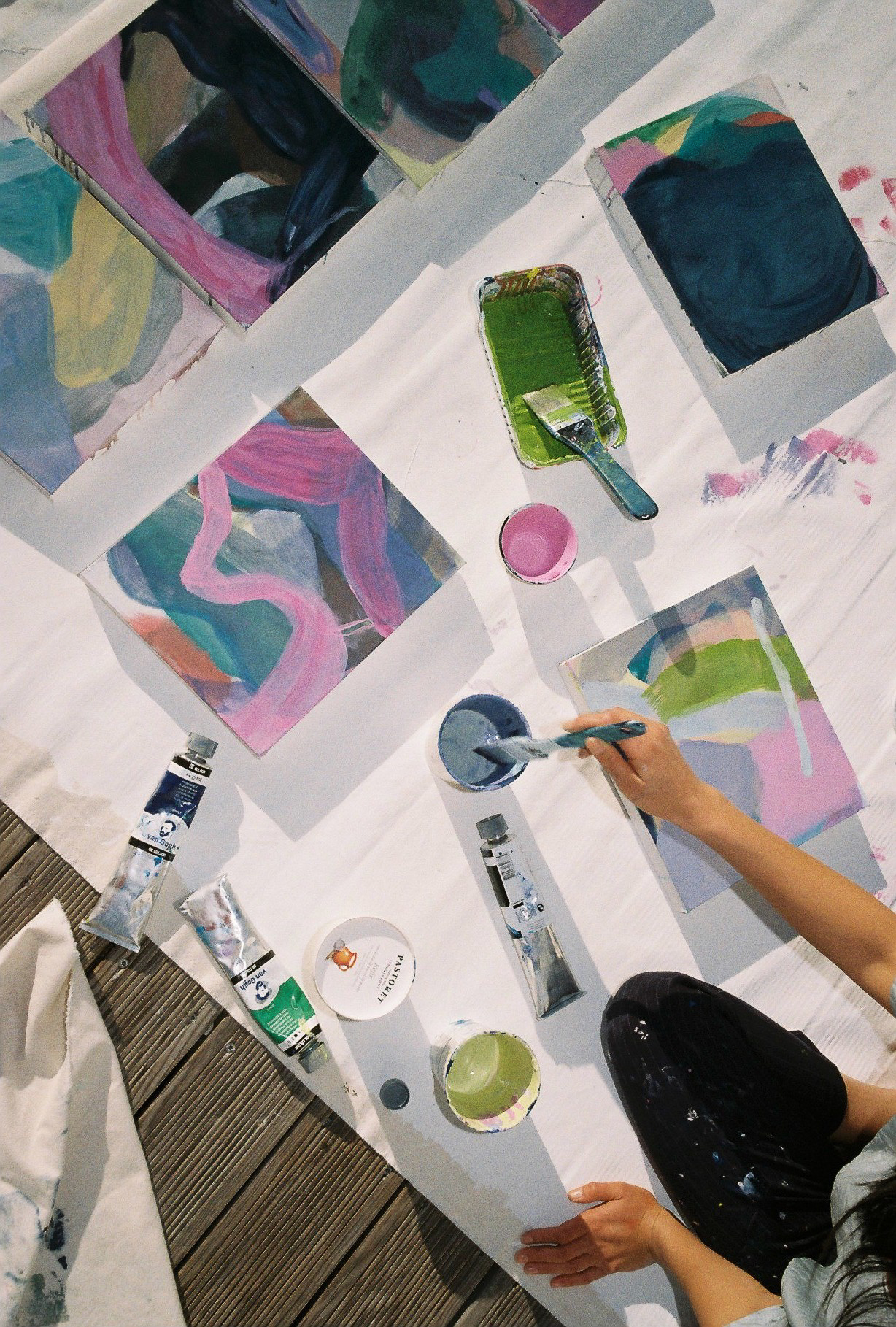









Emerging from the sun, the source of life is an energy that enlightens the darkness of the sky, enabling all that is below to become visible. In dreams, luminescence flows between neurons, submerging and surfacing. Among the visual data artist Laura Menzies absorbs from her surroundings, thoughts, and feelings is light. As she watches the textures, tones, and topographies in her paintings respond to the light entering her studio, Menzies finds herself immersed in her compositions as possibilities develop into ideas.

Menzies’ paintings are visually as well as conceptually poetic, as they capture consciousness and memories on canvas. The fluidity of her abstract compositions is drawn from the movement of the coastline that she lives next to. Tranquillity (2022) is an amalgamation of hues ranging from dark blue to light violet. This painting is inspired by the sea; it unfolds as a memory of stillness, placidity and calm. The painting Awakened (2022), a combination of yellow, blue and white tones, is a snapshot of her immediate Cornish environment.
The local landscape of the past winter, and the gradual transition into spring were inspirations for the artist. ‘It feels quite fresh, uplifting and joyous’ she explains, ‘it’s about lighter, brighter days.’ The ambiguous nature of her recent paintings allows them to be perceived in a variety of ways. They are highly lyrical; yet their simplicity renders them accessible.

Menzies’ studio is a sacred space with an air of limitless potential. ‘When I come here, I feel almost like I’m stepping into my own world,’ she says. ‘I feel very at peace, if the work is going well or I am in flow. I suppose the main purpose of my paintings is to slow people down and encourage them to linger and look closer.’
During her residency at Morgan’s Gallery, Falmouth, from January – March 2022, Menzies had access to a more expansive space. As a result, she gained a deeper understanding of the relationship between textures and natural light. The changing sunlight allowed her to view her compositions differently throughout the day. When she took a step back and viewed her paintings from a distance, she couldn’t help but notice the different textures she had created.


Having returned to her studio, the changing light now reveals visual stories, this time formed by natural luminosity interacting with the various markings present on the canvas. In Menzies’ compositions, layers of surface details with varying visibility can be viewed differently depending on the amount of daylight shining on them.
She applies the medium of cold wax to form her enigmatic paintings. Painting with wax dates back thousands of years to cave paintings and it has been used both in Roman portraits as well as more recent oil paintings. The thick paste is a mixture of beeswax and solvent often added to oil paint, and as the solvent evaporates the wax hardens. As a result, the drying time of the oil paint reduces and the density of the solution increases.


The process can also involve carving off a layer of paint, exposing the layer below. The surface consequently becomes exploitable as it can be manoeuvred by the artist with ease. ‘I am interested in building up the layers of my paintings, then scratching back through to reveal glimmerings of previous colour and marks,’ Menzies says.
Elements of her compositions can be subtracted or reformed; with cold wax, effortless creation and destruction can be easily realised. ‘When I’m working with the wax, I tend not to use any paint brushes,’ she reveals, ‘it’s more tools that you would usually find in a hardware store; it’s scrapers or sandpaper. Ceramic utensils work well for creating lines or different raised areas; it’s quite a physical process, which I enjoy.’


Menzies’ recent practice is influenced by Wabi-sabi, a Japanese aesthetic of accepting transience and imperfection. Some of its characteristics are asymmetry, roughness, simplicity, and an appreciation for natural objects and forces. She explains, ‘beauty can be found in imperfection,’ as these forms have a story and a history. In her work, addition and subtraction is ever-present.
Her desire to construct different surfaces is sated by her use of a variety of tools within her painting practice. Menzies collects and uses natural pigments in her work, alongside store-bought ones. She is not constrained by materials, paints or tools.

Alongside being an artist, Menzies is a trained art educator who has taught at Falmouth University, where she obtained an MA in Fine Art: Contemporary Practice in 2013. She currently organises workshops where she guides participants on how to make their own cold wax paintings.
Educating others is an integral part of Menzies’ practice as she offers advice, answers questions and explores new ways of perceiving her students’ work. As she explains, ‘I encourage participants to build up layers and work over these. I also encourage an experimental and playful approach with the paint, as then interesting things start to emerge visually.’

When it comes to her practice, Menzies has drive and perceptivity, however, she is not blinded by it. ‘I have a list to keep me on track, but if I wake up one day and I don’t feel like painting, I won’t force myself to do it. I’ll do some research or other tasks that need to be completed,’ she expresses.
‘I stop and go out to gather inspiration, or go out to see different things which then feed back into my work.’ Through her compositions, Laura Menzies invites people to ‘slow down, contemplate and momentarily lose themselves’ – a mantra that she lives by, as she sometimes slips and loses herself in life’s ebbs and flows.
10.06.2022
Words by Moriah Ogunbiyi
Related
Journal


